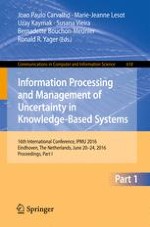This two volume set (CCIS 610 and 611) constitute the proceedings of the 16th International Conference on Information processing and Management of Uncertainty in Knowledge-Based Systems, IPMU 2016, held in Eindhoven, The Netherlands, in June 2016.
The 127 revised full papers presented together with four invited talks were carefully reviewed and selected from numerous submissions. The papers are organized in topical sections on fuzzy measures and integrals; uncertainty quantification with imprecise probability; textual data processing; belief functions theory and its applications; graphical models; fuzzy implications functions; applications in medicine and bioinformatics; real-world applications; soft computing for image processing; clustering; fuzzy logic, formal concept analysis and rough sets; graded and many-valued modal logics; imperfect databases; multiple criteria decision methods; argumentation and belief revision; databases and information systems; conceptual aspects of data aggregation and complex data fusion; fuzzy sets and fuzzy logic; decision support; comparison measures; machine learning; social data processing; temporal data processing; aggregation.
